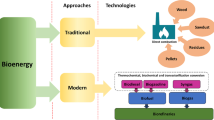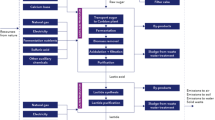Abstract
Background, aim, and scope
The rise in wood fuel consumption, particularly of charcoal, has been associated with increased deforestation in Ghana. Plantation developments from teak (Tectona grandis), bamboo (Bambusa balcooa), and Acacia auriculiformis are now being promoted to produce sustainable biomass for charcoal production. While all species have comparable charcoal quality, there is limited available data to elucidate the environmental impacts associated with their plantation development and use as biomass sources for producing charcoal. Therefore, this study quantified and compared the cradle-to-gate environmental impacts of producing charcoal from T. grandis, A. auriculiformis, and B. balcooa.
Methods
The study was conducted in accordance with ISO 14040/14044, an international procedural framework for performing life cycle analysis (LCA). For this study, the functional unit of charcoal used was 1 MJ energy produced from three species: T. grandis, A. auriculiformis, and B. balcooa. Data on B. balcooa plantations was collected from a B. balcooa-based intercropping system set up by the International Network for Bamboo and Rattan in Sekyere Central District, Ghana. Input data for A. auriculiformis and T. grandis came from the Forestry Commission of Ghana plantations established within the forest agroecological zone of Ghana. All input data came from primary local sources. Pollutant emissions were also calculated in order to analyze the contribution of all the flow processes to the emissions. The analysis used Simapro version 8, as well as life cycle inventory (LCI) databases of Ecoinvent V3 and Idemat 2015 (a database developed by Delft University of Technology, the Netherlands). The emissions were expressed as eco-costs and used as indicators in an impact assessment.
Results and discussion
The results showed that relative to B. balcooa, the total eco-cost (comprising of human health, ecosystem, resource depletion, and global warming eco-costs) of a cradle-to-gate production of 1 MJ of charcoal will be 140% higher with T. grandis and 113% higher with A. auriculiformis. The increased environmental impacts associated with T. grandis and A. auriculiformis occurred at their biomass production stage. As these species use comparatively large quantities of pesticides, weedicides, and fertilizers with high acidification, ozone depletion, and global warming potentials, their biomass production stage accounted for approximately 85% of their total eco-cost.
Conclusions
The study results suggest that B. balcooa plantations are the most environmentally viable option. In cases where T. grandis or A. auriculiformis plantations are widespread, improvement options at the biomass production stage are required in order to reduce their environmental costs.



Similar content being viewed by others
References
Agyemang KO, Amponsah O, Braimah I, Lurumuah S (2012) Commercial charcoal production and sustainable community development of the upper west region, Ghana. J Sustain Dev 5:149–164
Brentrup F, Küsters J, Lammel J, Kuhlmann H (2000) Methods to estimate on-field nitrogen emissions from crop production as an input to LCA studies in the agricultural sector. Int J Life Cycle Assess 5:349–357
Brentrup F, Küsters J, Kuhlmann H, Lammel J (2004) Environmental impact assessment of agricultural production systems using the life cycle assessment methodology: I. Theoretical concept of a LCA method tailored to crop production. Eur J Agron 20:247–264
Eco-cost value website (2016) The model of the eco-costs/value ratio (EVR) http://www.ecocostsvalue.com/EVR/model/theory/subject/2-eco-costs.html
Energy Commission of Ghana (2015) National Energy Statistics 2005–2014. Available at http://energycom.gov.gh/files/Energy%20Statistics_2015.pdf. Accessed on 15th November 2015
FAO (2010) Global forest resources assessment 2010. Food and Agriculture Organization of the United Nations, Rome
FAO, JRC (2012) Global forest land-use change 1990–2005. FAO forestry paper, 169
Fernández-Moya J, Alvarado A, San Miguel-Ayanz A, Marchamalo-Sacristán M (2014) Forest nutrition and fertilization in teak (Tectona grandis Lf) plantations in Central America. New Zeal J For Sci 44(Suppl 1):S6
Fuwape JA (1993) Charcoal and fuel value of agroforestry tree crops. Agroforest Syst 22:175–179
Growmore Biotech Ltd (2015) Development of Beema. Available at http://www.growmorebiotech.com/beema1.htm. Accessed on 18th October, 2015
Hauschild M (2000) Estimating pesticide emissions for LCA of agricultural products. In: Weidema BP, Meeusen MJG (eds) Agricultural data for life cycle assessment, vol II. Agricultural Economics Research Institute, The Hague
Heathwaite L (2000) Flows of phosphorous in the environment: identifying pathways of loss from agricultural land. In: Weidema BP, Meeusen MJG (eds) Agricultural data for life cycle assessment, vol 2. Agricultural Economics Research Institute, The Hague
ISO 14044 (2006) Environmental management—life cycle assessment—requirements and guidelines (ISO 14044:2006). ISO, Geneva
ITTO (2005) Ghana country profile, Status of tropical forest management (2005). [http://www.itto.or.jp/live/Live_Server/1233/Ghana.e.pdf]. Accessed on 1st April, 2015
Karmacharya SB, Singh KP (1992) Biomass and net production of teak plantations in a dry tropical region in India. Forest Ecol Manag 55:233–247
Kraenzel M, Castillo A, Moore T, Potvin C (2003) Carbon storage of harvest-age teak (Tectona grandis) plantations, Panama. Forest Ecol Manag 173:213–225
Nair PKR, Nair VD, Kumar BM, Haile SG (2009) Soil carbon sequestration in tropical agroforestry systems: a feasibility appraisal. Sustainability impact assessment and land-use policies for sensitive regions. Environ Sci Technol 12:1099–1111
Narayanaswamy V, Altham J, Van Berkel R, McGregor M (2002) A primer on environmental life cycle assessment (LCA) for Australian grains. Curtin University of Technology, Australia http://cleanerproduction.curtin.edu.au
Ntiamoah A, Afrane G (2008) Environmental impacts of cocoa production and processing in Ghana: life cycle assessment approach. J Clean Prod 16:1735–1740
Obiri BD, Oteng-Amoako AA (2007) Towards a sustainable development of the bamboo industry in Ghana. Ghana J Forest 21:14–27
Orwa C, Mutua A, Kindt R, Jamnadass R, Anthony S (2009) Agroforestree Database: a tree reference and selection guide version 4.0. (http://www.worldagroforestry.org/sites/treedbs/treedatabases.asp)
Oteng-Amoako A, Sarfo D (2005) Development of teak plantations in Ghana: propagation, processing, utilization and marketing. In ITTO/Kerala Forest Research Institute International Conference on Quality Timber Products of Teak from Sustainable Forest Management, Peechi, India
Rousset P, Aguiar C, Labbé N, Commandré JM (2011) Enhancing the combustible properties of bamboo by torrefaction. Bioresour Technol 102:8225–8231
Shanmughavel P, Francis K (1996) Biomass and nutrient cycling in bamboo (Bambusa bambos) plantations of tropical areas. Biol Fert Soils 23:431–434
van der Lugt P, Vogtländer J, Brezet H (2008) Bamboo, a sustainable solution for Western Europe: design cases LCAs and land-use. Centre for Indian Bamboo Resource and Technology
Vogtländer J, Van der Lugt P, Brezet H (2010) The sustainability of bamboo products for local and Western European applications. LCAs and land-use J Cleaner Prod 18:1260–1269
Acknowledgments
This research was carried out as an activity of BiomassWeb (grant no. 031A258A), a project funded by the German Federal Ministry of Education and Research (BMBF) in the context of the initiative GlobE “Securing the Global Food Supply”. BiomassWeb is managed by the Center for Development Research, Universität of Bonn, Germany. The authors wish to also thank Prof. J. Vogtländer, Delft University of Technology, The Netherlands, for sharing the Idemat 2015 database.
Author information
Authors and Affiliations
Corresponding author
Additional information
Responsible editor: Sonia Valdivia
Rights and permissions
About this article
Cite this article
Partey, S.T., Frith, O.B., Kwaku, M.Y. et al. Comparative life cycle analysis of producing charcoal from bamboo, teak, and acacia species in Ghana. Int J Life Cycle Assess 22, 758–766 (2017). https://doi.org/10.1007/s11367-016-1220-8
Received:
Accepted:
Published:
Issue Date:
DOI: https://doi.org/10.1007/s11367-016-1220-8




